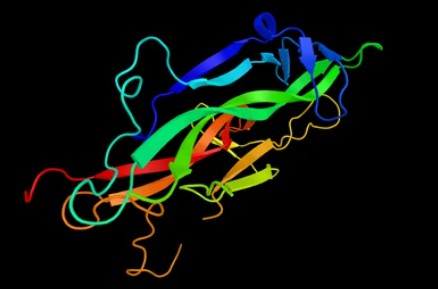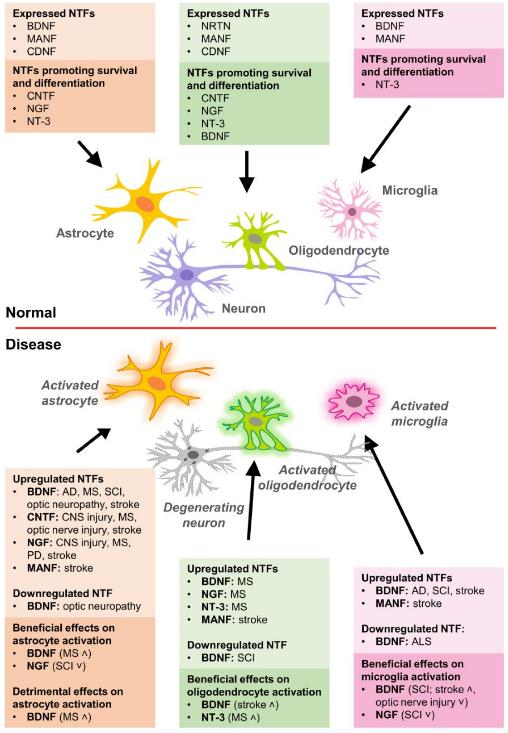Neurotrophic Factors and Receptors
About Neurotrophic Factors and Receptors
Neurotrophic factors and receptors play a crucial role in the development, survival, and maintenance of neurons in the central nervous system (CNS) and the peripheral nervous system (PNS). They are a group of proteins that regulate neuronal growth, differentiation, and plasticity.
Neurotrophic factors are secreted proteins that are primarily produced by target cells and act on neurons to promote their survival and function. They are classified into several families, including the nerve growth factor (NGF) family, the brain-derived neurotrophic factor (BDNF) family, the neurotrophin-3 (NT-3) family, and the glial cell line-derived neurotrophic factor (GDNF) family, and others.
These factors exert their effects by binding to specific receptors on the surface of neurons. There are several types of neurotrophic factor receptors, including the Trk receptors and p75 receptors. The Trk receptors (TrkA, TrkB, and TrkC) are typically responsible for mediating the survival and growth-promoting effects of neurotrophic factors, while the p75 receptor can modulate these effects.
Upon binding to their respective receptors, neurotrophic factors activate various intracellular signaling pathways that promote cell survival, inhibit apoptosis, enhance synaptic plasticity, and regulate neuronal differentiation and function.
Neurotrophic factors and receptors are essential for proper development and functioning of the nervous system. They are involved in processes such as axonal growth, dendritic arborization, synaptogenesis, and synaptic pruning. Additionally, they play a vital role in the repair and regeneration of damaged neurons in response to injury or disease.
Dysregulation of neurotrophic factors and receptors has been implicated in various neurological disorders, including neurodegenerative diseases like Alzheimer's disease, Parkinson's disease, and amyotrophic lateral sclerosis (ALS). Additionally, alterations in neurotrophic factor signaling have been linked to psychiatric disorders like depression, anxiety, and schizophrenia.

Common Neurotrophic Factors and Receptors
GDNF Family: One important family of neurotrophic factors is the glial cell line-derived neurotrophic factor (GDNF) family. This family includes GDNF, neurturin, artemin, and persephin. GDNF and its family members are secreted proteins that bind to specific receptors known as GDNF family receptors (GFRs). The GFRs include the tyrosine kinase receptors RET and GFRα1-4. GDNF family signaling is involved in the survival and differentiation of several types of neurons, including motor neurons and dopaminergic neurons.
Neurotrophin/Trk Family: The neurotrophin family is another important group of neurotrophic factors. This family includes nerve growth factor (NGF), brain-derived neurotrophic factor (BDNF), neurotrophin-3 (NT-3), and neurotrophin-4/5 (NT-4/5). Neurotrophins exert their effects by binding to specific tyrosine kinase receptors known as Trk receptors, such as TrkA, TrkB, and TrkC. These receptors are expressed on the surface of neurons and are responsible for mediating the survival, growth, and differentiation of various neuronal populations.
VPS10P-domain Family: The VPS10P-domain family is a relatively newly discovered group of neurotrophic factor receptors. This family includes sortilin, SorCS1, and SorLA. These receptors play a role in trafficking and sorting of neurotrophins and their receptors. They are involved in various processes, including neuronal survival and neurotrophin signaling.
Overall, neurotrophic factors and receptors are essential for the development and maintenance of the nervous system. Their dysfunction or imbalance can lead to various neurological disorders, such as neurodegenerative diseases and psychiatric disorders. Understanding the molecular mechanisms of neurotrophic factor signaling and their receptors is crucial for developing potential therapeutic interventions for these conditions.
 Fig.2 Expression of neurotrophic factors (NTFs) in glial cells and their effects on survival, differentiation, and activation of glia in normal and disease conditions. (Pöyhönen S, et al., 2014) AD, Alzheimer's disease; ALS, amyotrophic lateral sclerosis; MS, multiple sclerosis; PD, Parkinson's disease; SCI, spinal cord injury.
Fig.2 Expression of neurotrophic factors (NTFs) in glial cells and their effects on survival, differentiation, and activation of glia in normal and disease conditions. (Pöyhönen S, et al., 2014) AD, Alzheimer's disease; ALS, amyotrophic lateral sclerosis; MS, multiple sclerosis; PD, Parkinson's disease; SCI, spinal cord injury.
Research Tools for Neurotrophic Factors and Receptors
Creative BioMart offers a variety of products and services to support research on neurotrophic factors and receptors-related molecules.
Extensive Product Portfolio: We provide a range of products, including but not limited to recombinant proteins, cellular and tissue lysates, protein pre-coupled beads, designed to delve into the functionality and molecular mechanisms of neurotrophic factors and receptors, aiding in the development of potential therapeutic interventions for associated conditions.
Customized Services: Our scientific team, endowed with rich experience and expertise, can tailor specific proteins, antibodies, or experimental protocols to meet your unique research requirements.
Resource Support: In addition to product supply, we also provide extensive resource support. We provide information on pathways, protein functions, interacting proteins, relevant literature, and research fields related to neurotrophic factors and receptors to enhance your understanding and research on the functions and regulatory mechanisms of these key molecules.
If you have any questions or are interested in these products or services, please feel free to contact us and our customer service team will be happy to serve you. We look forward to interacting with you!
References:
- Pöyhönen S, Er S, Domanskyi A, et al. Effects of neurotrophic factors in glial cells in the central nervous system: expression and properties in neurodegeneration and injury[J]. Frontiers in physiology, 2019, 10: 486.
- Pezet S, McMahon S B. Neurotrophins: mediators and modulators of pain[J]. Annu. Rev. Neurosci., 2006, 29: 507-538.


